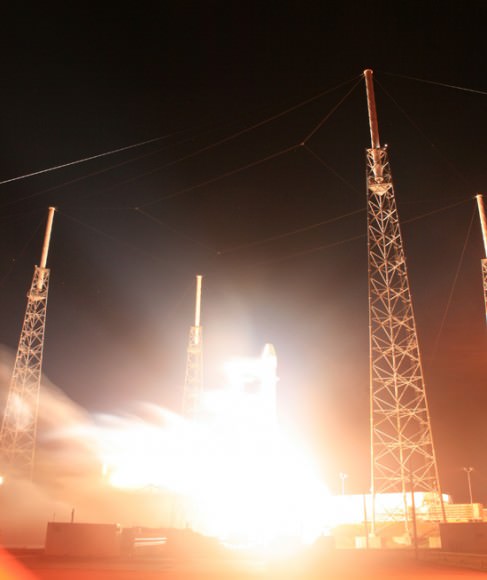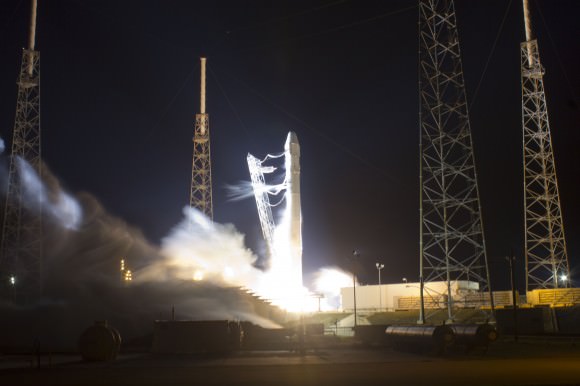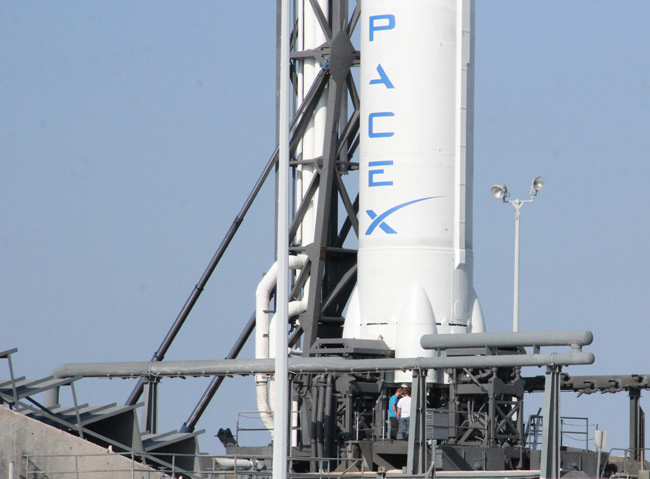[/caption]
Today’s (May 19) historic launch of the first ever privately developed rocket bound for the International Space Station (ISS) was very surprisingly aborted at the last second when an engine glitch forced a dramatic shutdown of the Falcon 9 rockets 1st stage firing already in progress and as the NASA launch commentator was in the middle of announcing liftoff.
SpaceX and NASA are now targeting liftoff of the mission dubbed COTS 2, for Tuesday, May 22 at 3:44 AM EDT from Space Launch Complex-40 on Cape Canaveral Air Force Station in Florida. There is another launch opportunity on May 23.
Later today, SpaceX engineers determined that a faulty valve caused the engine abort failure. They are now in a race against time to complete all the repair work and mandatory assurance testing required in order to be ready to achieve the new May 22 launch date.
The Falcon 9 rocket was designed and developed by SpaceX and the first stage is powered by nine Merlin 1 C engines. As the countdown clock ticked down to T-minus zero, all nine engines ignited. But engine #5 suddenly developed a “high chamber pressure” and computers instantaneously ordered a shutdown of thrust generation by all nine engines just 0.5 seconds from liftoff and the rocket therefore never left the pad, said SpaceX President Gwynne Shotwell at a briefing for reporters.
“We’ve had a cutoff,” announced NASA launch commentator George Diller. “Liftoff did not occur. We’ve had a launch abort. Standing by.”
After draining the explosive propellants, SpaceX engineers began inspecting the engines later today within hours of the aborted liftoff to determine the cause of the rocket engine malfunction.
“This is not a failure,” Shotwell told reporters at a post scrub media briefing. “We aborted with purpose. It would have been a failure if we lifted off with an engine trending in this direction.”
SpaceX may have caught a lucky break by being able to fix the rocket at the pad instead of a time consuming engine changout. Shotwell said that one possibility was to roll the Falcon 9 rocket back into the processing hangar and swap out the engine with a new one.
This evening SpaceX announced they had determined the cause of the engine failure.
“Today’s launch was aborted when the flight computer detected slightly high pressure in the engine 5 combustion chamber, said SpaceX spokeswoman Kirstin Grantham. “We have discovered root cause and repairs are underway.”

Credit: Ken Kremer/www.kenkremer.com
“During rigorous inspections of the engine, SpaceX engineers discovered a faulty check valve on the Merlin engine. We are now in the process of replacing the failed valve. Those repairs should be complete tonight. We will continue to review data on Sunday. If things look good, we will be ready to attempt to launch on Tuesday, May 22nd at 3:44 AM Eastern.”
The purpose of Dragon is to carry some 1200 pounds of supplies up to orbit and dock at the ISS and partially replace the capabilities of NASA’s now retired space shuttle.

SpaceX is under contract with NASA to conduct twelve resupply missions to carry about 44,000 pounds of cargo to the ISS for a cost of some $1.6 Billion.


ISS has seen 115 dockings since November 1998 (if i counted correctly)
Not that i’m superstiteous, but with a commercial parcel delivery service on the way, it wouldn’t surprise me if after those 115 dockings a dog would magicaly spawn to start barking and biting at the first “Mailman”. Who knows, Laika might have decided space is the perfect spot to start haunting.
this is no time to make the N.Koreans look good..
Best post yet! 🙂
Best post yet! 🙂
North Koreans have failed at every rocket attempt, are extortionists, war mongers, provocateurs, and are letting their own citizens starve to death at the expense of their obsession of getting nukes into orbit.
Totally irrelevant, and possibly the WORST post yet!
I could care less if you don’t like it zcrank, I’m not here to please the likes of YOU.
Figures, a check valve is about the simplest tubing and should seldom fail. =D
Luckily it is easily replaced if they can get to it, which seems to be the case.
Ahem! Good engineering. If it had been the Shuttle’s hard pressed and heavily shielded main engines, it could have been months of repairs as I remember it. And a solid booster part failure – forgeddaboudit I think, replacement should in most cases be the fix.
Another feather in the SpaceX hat, if they can (s)wing it. By the way, I am now considering becoming a fan boi, where do fan bois/gals** sign up?*
I was going to complain about the description, as I did yesterday, then I got the semi-bright idea of checking the mutually sourced press kit.
What do you know, they have changed back the “COTS 2+” moniker that was floated earlier this year! Earlier comment amended as appropriate.
——————————-
* Which puts the question, where do the hate bois and gals sign up anyway? They seem to outnumber the fan bois & gals 2:1, reading the press and blogs.
‘** I would have thought it was “fan gurl”, but apparently not.
Here’s a fitting video clip: http://www.youtube.com/watch?v=JYc05gZFly0
ummm….it was only one engine, and not even an engine, just a check valve. Please don’t make it worse than it is to make a better headline.
thanks.
In such a complex system as this, the slightest glitch can and will lead to catastrophic failure! Your comment: “It was only one engine.” is silly at best, and stupid at worst. If they could do without that engine, then why have it in the first place? Put it this way: Would YOU like to be on-board that rocket with a malfunctioning engine? ummmmm!
I don’t know whether this malfunction would have destroyed the rocket, but in at least some cases the Falcon 9 can get by with 8 engines instead of 9. It has “engine out capability”, meaning that when one engine goes out, the remaining 8 can either be upthrusted or run longer to compensate. The engines on the Falcon 9 are also designed so that they can be contained in the event of an explosion, just like engines on commercial jets.
The Falcon Heavy is suppose to have multi-engine out capability, being able to lose at least 3 engines and still complete its mission.
In such a complex system as this, the slightest glitch can and will lead to catastrophic failure! Your comment: “It was only one engine.” is silly at best, and stupid at worst. If they could do without that engine, then why have it in the first place? Put it this way: Would YOU like to be on-board that rocket with a malfunctioning engine? ummmmm!
Really….. This ship has an indicator light for a flippin’ check-valve. I’d like to see one of those check valves. They must prevent hot gas or oxidizer from backtracking into the fuel tank once the fuel pump shuts down. I guess that is slightly more important than the check valve screwed into my pooper pump.
Skip,
The headline read engines (plural), and as I said, it wasn’t more than one engine, it was an external component – on only one engine. Having the fan belt break on your car’s engine can lead to catastrophic failure, but isn’t in itself catastrophic. The ‘red light on the dash’ came on, they shut the mission down, same as you would if it happened on your car, thus was catastrophe avoided. Fortunately, the mission was still on the ground instead of a foot into the sky.
I’m fine with that, only a fool would launch (or drive) with the light flashing.
I’m not fine with ‘bending’ the story for a more sensational headline. THAT is ‘silly at best, and stupid at worst’ Much harm is done to the scientific community by inaccurate reporting. It troubles me to see it on this site.
Keep in mind that the Falcon9 is a human rated rocket designed to ferry humans to orbit. So we should have nothing but the most reliable rocket which scrubs launch on signs of possible failure rather than the “just launch” attitude.
The analogy between a car and a rocket is fallacious since if a Car fails it isn’t going to crash and burn. The worst thing for human spaceflight is a rocket that isn’t designed to handle component failure and the “just launch and pray” attitude that has works as long as humans aren’t the cargo. The way the Falcon9 handled the valve failure raises the respect level by orders of magnitude.
We can expcect nothing but the highest standards from SpaceX , and the way they are handling this incident shows nothing but thier professionalism that they are not only fixing the valve but revalidating all systems are ready to go on a very tight schedule.
The fact that a fail-safe system actually kicked in instead of blowing up the rocket is a good sign. The Space Shuttle also had aborted launches.
But since this is a private company, they should do better than NASA since a failure would mean loss of investors.
The fact that a fail-safe system actually kicked in instead of blowing up the rocket is a good sign. The Space Shuttle also had aborted launches.
But since this is a private company, they should do better than NASA since a failure would mean loss of investors.
Hey Russel,
there is nothing wrong with using the plural engines, since the failure was a component concerning the engines section of the rocket.
Also, a good engineer would at least do a check on the other engines to see if the failure is local or general to avoid the same problem on Tuesday’s attempt. You definitely do not want the comment: “Why didn’t you check the rest while you were at it”.
Multiple choice answer:
a) didn’t care
b) it was just that one that failed
c) didn’t think of it
d) checking the others would mean we allow doubt about our quality.
e) they were already launch qualified, it cannot fail.
Thanks all for your insightful comments, all of which are good looks at the safety of the craft, but you’re not getting my point. The headline reads that ‘engineers are racing to repair engines’ – as though MORE THAN ONE ENGINE malfunctioned. ONE check valve malfunctioned, NOT an engine.
What it is that malfunctioned, what color light (actually, a binary computer code) lit up, isn’t the point.
While it is a very good thing, and a testament to the folks at SpaceX, that they have sensors on every single component, and make them accessible for repair, too, that’s not the point. If they decide to replace all the check valves just in case, good on them. This is a giant step for spaceflight, this launch, I’m quite sure they (and all of us) want to get it just right!
BUT: If I didn’t have a few minutes to click on the ”more’ ,and read it carefully, I’d have been left with an incorrect information package (the headline as written) about the aborted launch.
It’s not about SpaceX, it’s about how the headline was written!
Oh by the way……I am a volunteer firefighter…… and an auto CAN most certainly crash and burn, and take lives in the process, if an engine seizes up at speed. But that’s not what this is about, either.
I’ll be quiet and go back in my box, now…..
R
Russel,
I agree mostly, the headline is misleading as to the content of the story and what is known. Only one engine is invloved but as the check valve is part of the engine assembley using the engine descriptor is excusable as earlier information was that the engine may have had to be replaced.
I would bet there are some minor components on each engine that require repair/replacement each time a start occurs regardless of the duration of the burn.
What a ‘bummer’… stupid check valve! The delay(s) are to be expected, given the complexity of space flight. I can think of dozens of launches that SHOULD have been aborted but were’nt…